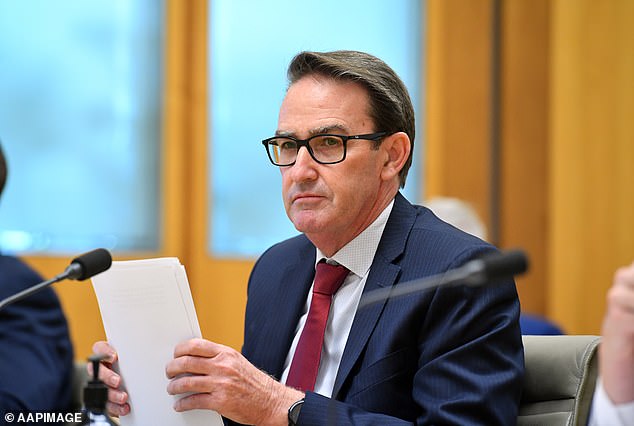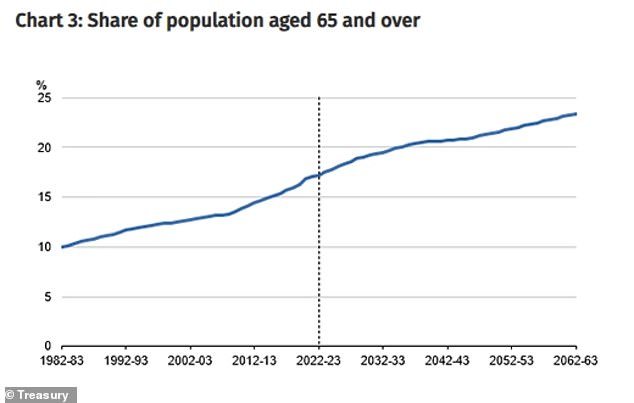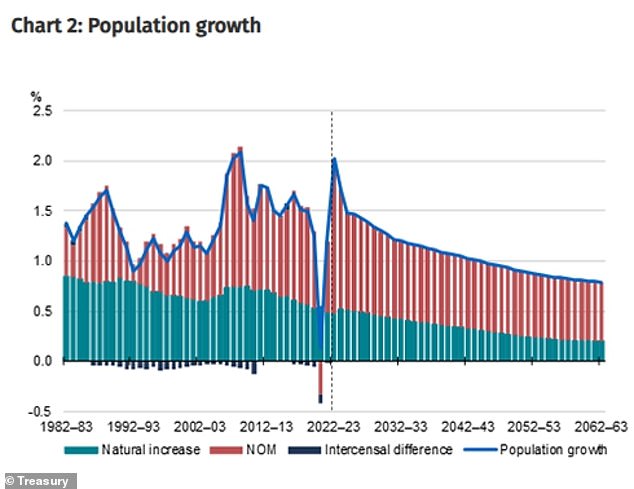Reason record numbers of migrants are flooding into Australia is exposed by top government official
One of Australia’s most powerful public servants has used predictions of an aging population and a falling birth rate to justify record immigration.
Steven Kennedy, the Treasury secretary, who also sits on the Reserve Bank’s board, criticized the notion that a rapidly aging population would be temporary.
“There is sometimes a perception that population aging is a temporary phenomenon, particularly with baby boomers,” he told Australia’s Economic Development Committee on Monday.
“However, this is not the case.”
Dr Kennedy quoted from the Treasury’s Intergenerational Report which predicts the proportion of people aged 65 and over will rise to 23.4 per cent by 2062-63, up from 17.3 per cent last financial year.
The proportion of those aged 85 and over was forecast to rise to five per cent, from 2.9 per cent.

One of Australia’s most powerful public servants has used forecasts of an aging population and a falling birth rate to justify record immigration (pictured is Sydney Town Hall station)
This comes as Australia’s fertility rate falls, with couples having an average of fewer than two children, or below replacement level.
“As long as the fertility rate is below replacement, successive generations will be smaller,” Dr Kennedy said.
Australia’s fertility rate has been below 2.1 since the 1970s, with the 2008-09 level of 1.98 a temporary high in recent years.
Higher immigration in recent decades has failed to stop Australia’s population from aging, with the Treasury’s Population Center estimating the nation’s median age to be 38 years and six months in mid-2022, up from 32 years and eight months three decades ago.
However, Dr Kennedy said Australia’s population would be even older without the increase in immigration of the past two decades.
“High migration has been the main driver of the larger and younger population,” he said.
“Our population growth has been higher than all G7 countries, reflecting higher migration.”
A record 454,400 migrants moved to Australia in the year to March, with the figure including both permanent intake of skilled migrants and long-term international students.
Australia’s net overseas migration rate, based on arrivals minus permanent departures, has quadrupled from the 110,104 level of two decades ago.
A surge in immigration, to offset Australia’s border closures in 2020 and 2021, has also coincided with a drop in productivity, with output per worker falling.
Productivity, based on gross domestic product per hour, fell by 3.6 percent in 2022-2023.
Over the past decade, when 200,000 migrants have moved to Australia a year, productivity growth has remained below one per cent.
That’s a far cry from the two percent pace of the 1990s, when annual immigration was mostly below 100,000.
But Dr Kennedy said an aging population would mean weaker than average economic growth in the coming decades.
“Lower growth reflects slower productivity and population growth, and reduced participation due to aging,” he said.
Slower projected productivity, population growth and lower participation are not unique to Australia.
“These results are predicted for most developed countries.”

Steven Kennedy, the Treasury secretary, who also sits on the Reserve Bank’s board, criticized the notion that a rapidly aging population would be temporary.

Dr Kennedy quoted from the Treasury’s Intergenerational Report which predicts the proportion of people aged 65 and over will rise to 23.4 per cent by 2062-63, up from 17.3 per cent last financial year
Australia’s population grew by 2.2 per cent in the year to March with immigration accounting for 80.7 per cent of the increase.
But Treasury expects this to slow to 1.1 per cent over the next 40 years, putting it below the 1.4 per cent of the past four decades, as Australia’s population grows from 26.5 million to 40.5 million with 2062–63.
The Treasury advocates higher immigration so that it can reap more tax revenue.
The Business Council of Australia, which represents big corporations, has lobbied for higher immigration since borders reopened in late 2021.

Treasury expects population growth to slow to 1.1 per cent over the next 40 years, putting it below the 1.4 per cent rate of the past four decades, as Australia’s population grows from 26.5 million to 40.5 million by 2062–63.
(tagsTranslate) daily mail(s) news(s) G7(s) fertility

